On one of those gloomy, gray, and gross days last week I met up with 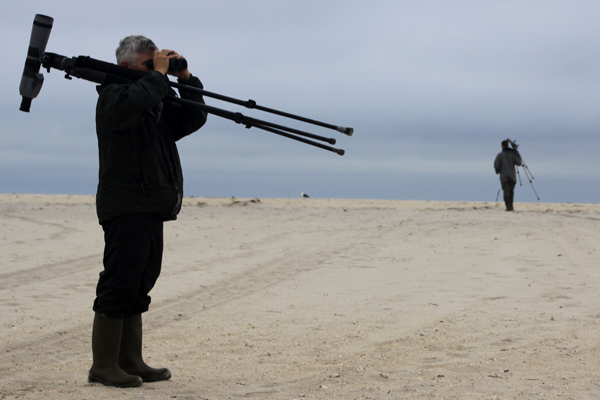 Doug and Shane, those two irrepressible Brooklyn birders, and we made our way to Nassau County, just east of New York City on Long Island, for some birding along the coast. The cloud-filled sky occasionally drizzled on us, sometimes rained on us, and mostly just brooded about its impotence. We were three birders out to bird and we were not about to let mere weather prevent our outing.
Doug and Shane, those two irrepressible Brooklyn birders, and we made our way to Nassau County, just east of New York City on Long Island, for some birding along the coast. The cloud-filled sky occasionally drizzled on us, sometimes rained on us, and mostly just brooded about its impotence. We were three birders out to bird and we were not about to let mere weather prevent our outing.
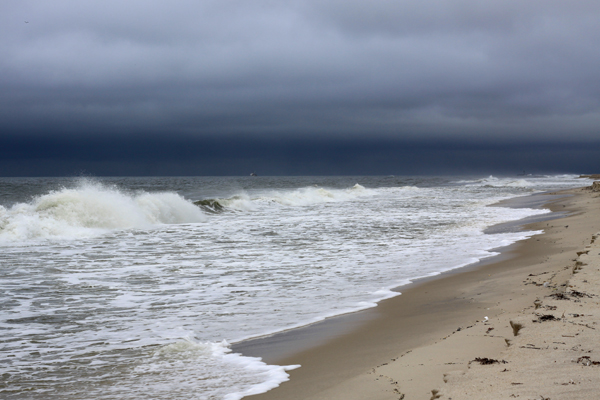 Our first stop, after brief looks at rather large numbers of shorebirds at Big Egg Marsh in Queens, was Jones Beach, usually packed with sunbathers and swimmers in summer but on the particular day we were there we had the coast nearly to ourselves. Well, we had the place to ourselves if you don’t count the hordes of shorebirds that were all over the place. Black-bellied Plovers foraged in the median, Semipalmated Sandpipers wandered across parking lots, Lesser Yellowlegs flew through the air, and we three birders reveled in the sheer spectacle of shorebirds everywhere!
Our first stop, after brief looks at rather large numbers of shorebirds at Big Egg Marsh in Queens, was Jones Beach, usually packed with sunbathers and swimmers in summer but on the particular day we were there we had the coast nearly to ourselves. Well, we had the place to ourselves if you don’t count the hordes of shorebirds that were all over the place. Black-bellied Plovers foraged in the median, Semipalmated Sandpipers wandered across parking lots, Lesser Yellowlegs flew through the air, and we three birders reveled in the sheer spectacle of shorebirds everywhere!
Above are a whole big bunch of roosting American Oystercatchers and below are shorebirds at Jones Beach. Can you give the name of each species in the image below? (You can click it to make it bigger)
What else was around beyond what was already mentioned? Well, a horde of Tree Swallows, some Western Sandpipers, several species of tern, and, best of all, my first-ever-in-Nassau County Whimbrel! Shane found it roosting in the grassy swale at West End 2 and, after we wandered up the beach and counted nearly 200 Red Knots we came back to the swale and the Whimbrel flew past a couple of times, calling loudly.
After the Whimbrel, and after our inability to find any “grasspipers” we needed a plan of action. Shane suggested Dunkin’ Donuts and I backed him up over Doug’s objections (Doug would bird us to death if he could, and, if you have birded with me, you know that for me to say that someone else would bird me to death means that Doug must be crazy). So, to Dunkin’ Donuts we went where the only bird we saw was a House Sparrow but we did enjoy coffee and donuts. Our next stop was Cow Meadow Park and Preserve where I neglected to take a single picture of the horde of herons, the Long-billed Dowitcher, or anything else. I did not make the same mistake at our final stop, the Marine Nature Study area, where an American Avocet had been reported.
As you can see from the photo above, we found the avocet without any difficulty, and also enjoyed 18 Yellow-crowned Night-Herons (!), a couple of Black-crowned Night-Herons, Savannah, Song, Saltmarsh, and Seaside Sparrows, several Osprey, and our second Long-billed Dowitcher of the day.
We also got great looks at a juvenile Seaside Sparrow and a juvenile Saltmarsh Sparrow, and I managed to get decent digscoped shots of them (keep an eye out for a gallery). The Marine Nature Study Area is really a great place to bird because of the inherent coolness of saltmarshes, the great birds that show up there, and the willingness of those great birds to allow close approach. Of course, pretty much all of coastal Nassau County has great birding and I am glad that the three of us got to do a pretty thorough search of it and see some sweet species.
…


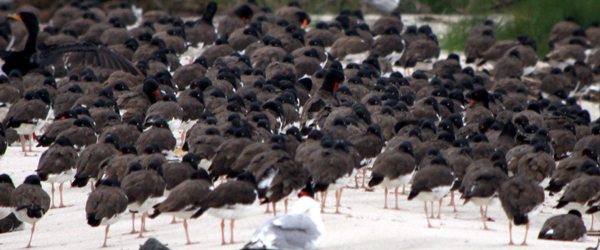
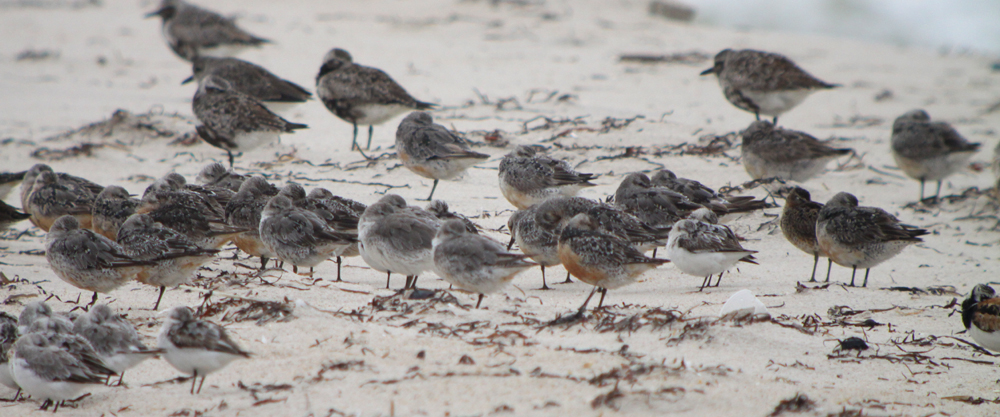
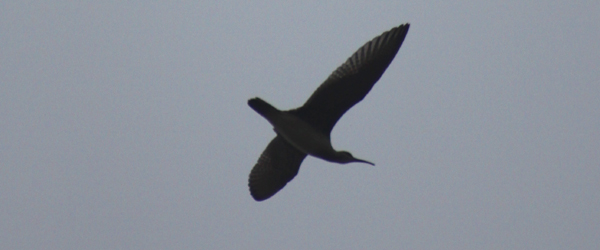
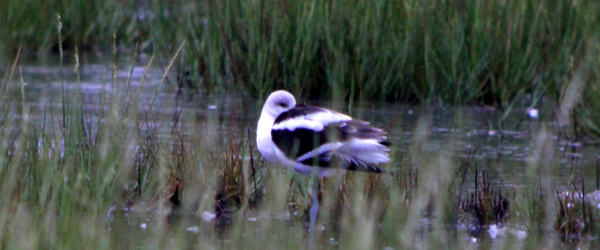
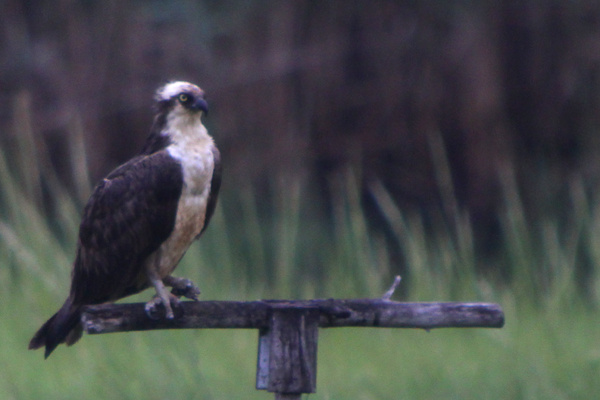
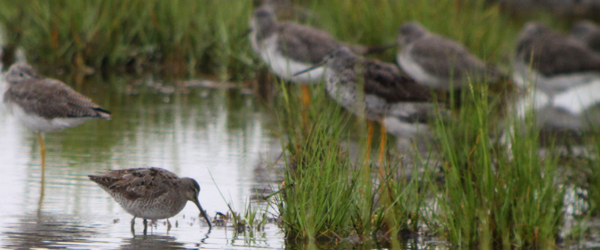
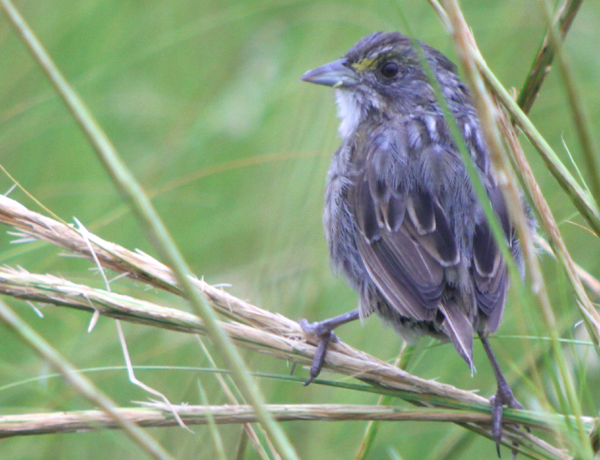
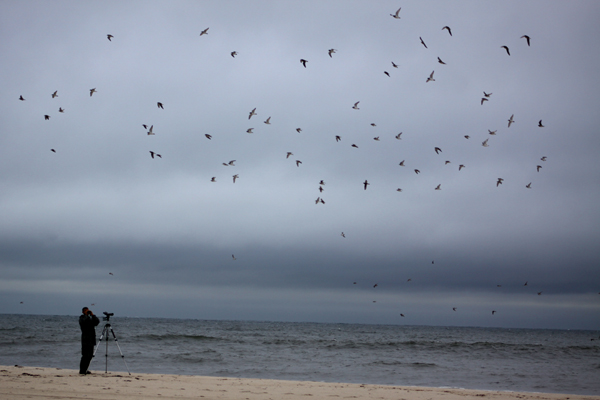











Hmpf, this would have been a day with 5+ lifers for me, and yes, I saw your announcement that you will soon come forward with a picture of 18 Black-crowned Night-herons photoshopped into “Yellow-crowneds”.
On a more serious note (now, am I ever…), the bird on the far right of your Jones Beach picture, half hidden behind a Red Knot, looks strange, with a smaller body and longer legs. Any ideas?
Cheers!
@Jochen: I know exactly what it is…but all you get to know is that it isn’t a YCNH. 🙂
Okaaaaay …
Well, there’s no way to be certain from that pic alone (in my humble opinion), but if this was a beach in Germany, I’d suspect (no more than that) it to be a species that would merit its own post on 10,000 Birds and that has a striking feature in common with a certain “Bad-Ass Sandpiper”.
But as I said, this is fairy tale territory without additional pictures.
My guesses on the shorebirds would be Red Knot, Black-bellied Plover, Sanderling, Ruddy Turnstone, and probably Short-billed Dowitcher (which, unlike the bird Jochen is referring to, would not merit its own post but does share that distinctive feature).
I think I see Doug looking the wrong way in that last picture. He must have been thrown off his game by Dunkin’ coffee.
@Eamon C: I also considered dowitcher (which by all probability it is) but isn’t it a bit short-legged for one?
@Jochen and Eamon: SBDO it is, and Eamon got all the other birds correct as well. I so wish it was that other bird that Jochen is dreaming of for me.
@Nick: We really messed him up with donuts.
To my defense: it does look rather short-legged and the legs appear dark, not yellowish as they should on a “Deutsche snipe”. And then of course, my complete failure and lapse of reason can easily be explained away by not having seen any dowitchers at all for 3+ years.
Oh, and then I found this picture, and the suspense spilled over:
http://www.tarsiger.com/gallery/index.php?pic_id=Roope1250589707&lang=eng
Better luck next time, I presume.
🙂
While at my landscape job,I spotted 5 parrots that were squauking
it up in a near by tree. This was on October 11, 2010 in Bellmore,south of Merrick Rd. I have seen 3 more the same week
in Merrick down near the water. What do they do in the winter?
@Steve: What you are seeing are almost undoubtedly Monk Parakeets (sometimes called Quaker Parrots), an introduced species that thrives in temperate climates. They are adept at finding food sources, from fruit left on trees to bird feeders, and are an oddity in that they build big, bulky, nests made of sticks in which they huddle during the winter to keep warm. Often these nests are based on power poles, stadium lights, or other man-made sources of warmth. If you google Monk Parakeets or Quaker Parrots you will find a wealth of information about them.
hey corey, great site !
can you educate me…do you know what birds populate atlantic beach, new york? i am writing a personal piece to be published in a collection of writings by women healers and have some reference to them. thanks so much, rachel
@Rachel: There are a host of gulls, shorebirds, and other species. I would recommend picking up a cheap pair of binoculars and either the Sibley or the Peterson eastern field guides – you will not regret the time you spend figuring out the birds that you are seeing.
Has anyone seen the wild parrots around Bellmore? I have seen them twice this year.